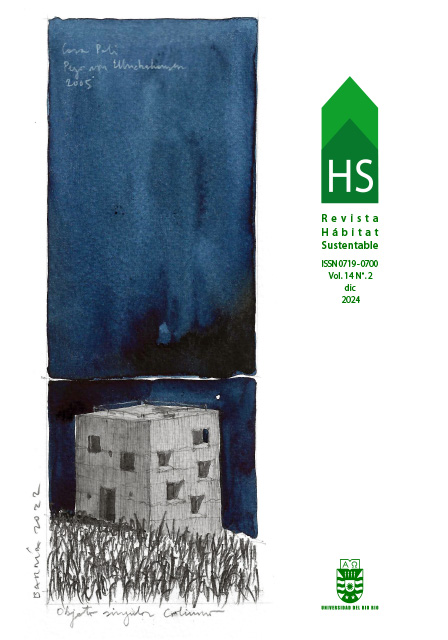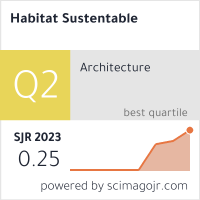Analysis of evolutionary morphologies with CFD: Improving natural ventilation in central courtyard housing, in semi-warm areas of Latin America
DOI:
https://doi.org/10.22320/07190700.2024.14.02.04Keywords:
evolutionary design, natural ventilation, sustainable architecture, CFD in central courtyard housingAbstract
This study aims to reduce energy demand in architecture through the use of passive strategies, specifically focusing on natural indoor ventilation. Computational simulations (CFD: Computational Fluid Dynamics) were conducted, and parametric algorithms in Grasshopper were employed, applying a methodology based on evolutionary design. The objective is to optimize the design of single-family courtyard houses with cross-ventilation by evaluating how the morphology of these houses influences their performance in terms of natural ventilation. Through morphogenesis processes and evolutionary design, more than 200 morphological variations (samples) were generated, whose results allowed for the selection of the best-performing models. The most successful genes were combined in new generations to repeat the evaluations, ultimately achieving a housing model that optimizes ventilation up to 2.5 times more than the traditional courtyard house model.
Downloads
References
ALLEN, O. H. (2009). Fitness and its role in evolutionary genetics. Nature Reviews Genetics,10, 531-539. https://doi.org/10.1038/nrg2603
ASCE. (2023a). Appendix D: Effective Strategies to Reduce Dynamic Wind-Induced Response in ASCE, Prestandard for Performance-Based Wind Design (V1.1, pp. 107-108). American Society of Civil Engineers. https://doi.org/10.1061/9780784482186
ASCE. (2023b). Chapter 6: Modeling and Analysis. in ASCE, Prestandard for Performance-Based Wind Design (V1.1, pp. 34-45). American Society of Civil Engineers. https://doi.org/10.1061/9780784482186
ASCE. (2023c). Chapter 5.2.2: Site-Specific Hazard Analysis in ASCE, Prestandard for Performance-Based Wind Design. (V1.1, pp. 23-25). American Society of Civil Engineers. https://doi.org/10.1061/9780784482186
ASCE. (2023d). Chapter 5.3: Wind tunnel test methodologies in ASCE, Prestandard for Performance-Based Wind Design (pp. 25-30). American Society of Civil Engineers. https://doi.org/10.1061/9780784482186
ASHRAE. (2009). INDOOR ENVIRONMENTAL QUALITY, Chapter 13: Indoor Environmental Modeling (TC 4.10, Indoor Environmental Modeling) in ASHRAE, Handook: Fundaments. American Society of Heating, Refrigerating and Air-Conditioning Engineers. https://www.ashrae.org/technical-resources/technical-committees/complete-list-of-tcs-with-home-pages
BANZHAF, W. (2013). Chapter 17: Evolutionary Computation and Genetic Programming in A. Lakhtakia, & R. J. Martín Palma (Eds), Engineered Biomimecry (pp. 430-447). Oxford: Elsevier. https://doi.org/10.1016/B978-0-12-415995-2.00017-9
BENSALEM, R. (1996). Wind-Driven Natural Ventilation in Courtyard and Atrium Type Buildings [Thesis Doctor, School of Architectural Studies. University of Sheffield]. https://etheses.whiterose.ac.uk/3000/1/DX197102.pdf
ECHEVERRI MONTES, P. (27 septiembre de 2021). Grasshopper para Rhino: ¿qué es y cómo se utiliza? Echeverrimontes. https://www.echeverrimontes.com/blog/grasshopper-para-rhino-que-es-y-como-se-utiliza
EL AHMAR, S., BATTISTA, F., y FIORAVANTI, A. (2019). Simulation of the thermal performance of a geometrically complex Double-Skin Facade for hot climates: EnergyPlus vs. OpenFOAM. Building Thermal, Lighting, and Acoustics Modeling, 12, 781-795. https://doi.org/10.1007/s12273-019-0530-8
FUTUYMA, D. J. (2017). Section III: Natural selection and adaptation in J. Losos (Ed.), Princeton Guide of Evolution (pp. 189-200). Princeton University Press. https://www.kokkonuts.org/wp-content/uploads/jennions_kokko_2014_The_Princeton_Guide_to_Evolut.pdf
IURATO, G., y IGAMBERDIEV, A. U. (2020). D’Arcy W. Thompson’s On Growth and Form: A landmark for the mathematical foundations of epigenetics. BioSystems, 198, 104279. https://doi.org/10.1016/j.biosystems.2020.104279
Ladybuy Tools (LLC). (2022). Butterfly.https://www.ladybug.tools/butterfly.html
MALKAWI, A. M., SRINIVASAN, R. S., YI, Y. K., y CHOUNDHARY, R. (2005). Decision support and design evolution: integrating genetic algorithms: CFD and visualization. Automation in Construction, 14(1), 33-44. https://doi.org/10.1016/j.autcon.2004.06.004
OpenFOAM. (2019). OpenFoam: User Guide v2112. https://www.openfoam.com/documentation/guides/latest/doc/guide-bcs-derived-wall.html
RODRIGUES MARQUES SAKIYAMA, N., FRICK, J., BEJAT, T., y GARRECHT, H. (2021). Using CFD to Evaluate Natural Ventilation through a 3D Parametric Modeling Approach. Energies, 14 (8)., 2197. https://doi.org/10.3390/en14082197
Soler & Palau. (2022, Albril). Velocidad del aire. Los efectos y la velocidad del aire. S&P (Soler & Palau Ventilation Group). https://www.solerpalau.com/es-es/hojas-tecnicas-velocidad-del-aire/
TABLADA DE LA TORRE, A. E., BLOCKEN, B., CARMELIET, J., DE TROYER, F., y VERSCHURE, H. (13-16 de noviembre de 2005). The influence of courtyard geometry on air flow and thermal comfort: CFD and thermal comfort simulations. In Proceedings of the 22nd Conference on Passive and Low Energy Architecture (Vol. 1, pp. 75–80). NDU Publishing; Lebanon.
WERRITTY, A. (2010). D'Arcy Thompson's ‘On Growth and Form’ and the Rediscovery of Geometry within the Geographic Tradition. Scottish Geographical Journal, 126(4), 231-257. https://doi.org/10.1080/14702541.2010.549344
WHITLOCK, M. C. (2014). Section I.4: From DNA to Phenotypes in J. Losos (Ed.), Princeton Guide of Evolution. (pp. 40-49). Princeton Univeristy Press. https://www.kokkonuts.org/wp-content/uploads/jennions_kokko_2014_The_Princeton_Guide_to_Evolut.pdf
Wolf Dynamics. (2018). Mesh generation using snappyHexMesh. http://www.wolfdynamics.com/wiki/meshing_OF_SHM.pdf
ZAMANI, Z., TALEGHANI, M., y HOSEINI, S. B. (2012). Courtyards as solutions in green architecture to reduce environmental pollution. Energy Education Science and Technology Part A: Energy Science and Research, 30 (1)., 385-396. https://repository.tudelft.nl/file/File_c83b7492-d5d2-4e89-8554-017b6d40e7f7?preview=1
ZHENG, J., TAO, Q., y LI, L. (2020). Numerical study of wind environment of a low-rise building with shading louvers: Sensitive analysis and evaluation of cross ventilation. Journal of Asian Architecture and Building Engineering,19(6), 541-558. https://doi.org/10.1080/13467581.2020.1758113
ZHONG, W., SCHRÖDER, T., y BEKKERING, J. (2021). Biophilic design in architecture and its contributions to health, well-being, and sustainability: A critical review. Frontiers of Architectural Research, 11(1), 114-141. https://doi.org/10.1016/j.foar.2021.07.006
Downloads
Published
How to Cite
Issue
Section
License
Copyright (c) 2024 Diego Rodríguez-de-Ita, Liliana Beatriz Sosa-Compeán

This work is licensed under a Creative Commons Attribution-ShareAlike 4.0 International License.
The content of articles which are published in each edition of Habitat Sustentable, is the exclusive responsibility of the author(s) and does not necessarily represent the thinking or compromise the opinion of University of the Bio-Bio.
The author(s) conserve their copyright and guarantee to the journal, the right of first publication of their work. This will simultaneously be subject to the Creative Commons Recognition License CC BY-SA, which allows others to share-copy, transform or create new materials from this work for non-commercial purposes, as long as they recognize authorship and the first publication in this journal, and its new creations are under a license with the same terms.











 Scientific Information Program/Concurso Fondos de Publicación de Revistas Científicas 2018/ Proyecto Mejoramiento de Visibilidad de Revistas UBB (Código:FP180007).
Scientific Information Program/Concurso Fondos de Publicación de Revistas Científicas 2018/ Proyecto Mejoramiento de Visibilidad de Revistas UBB (Código:FP180007).





